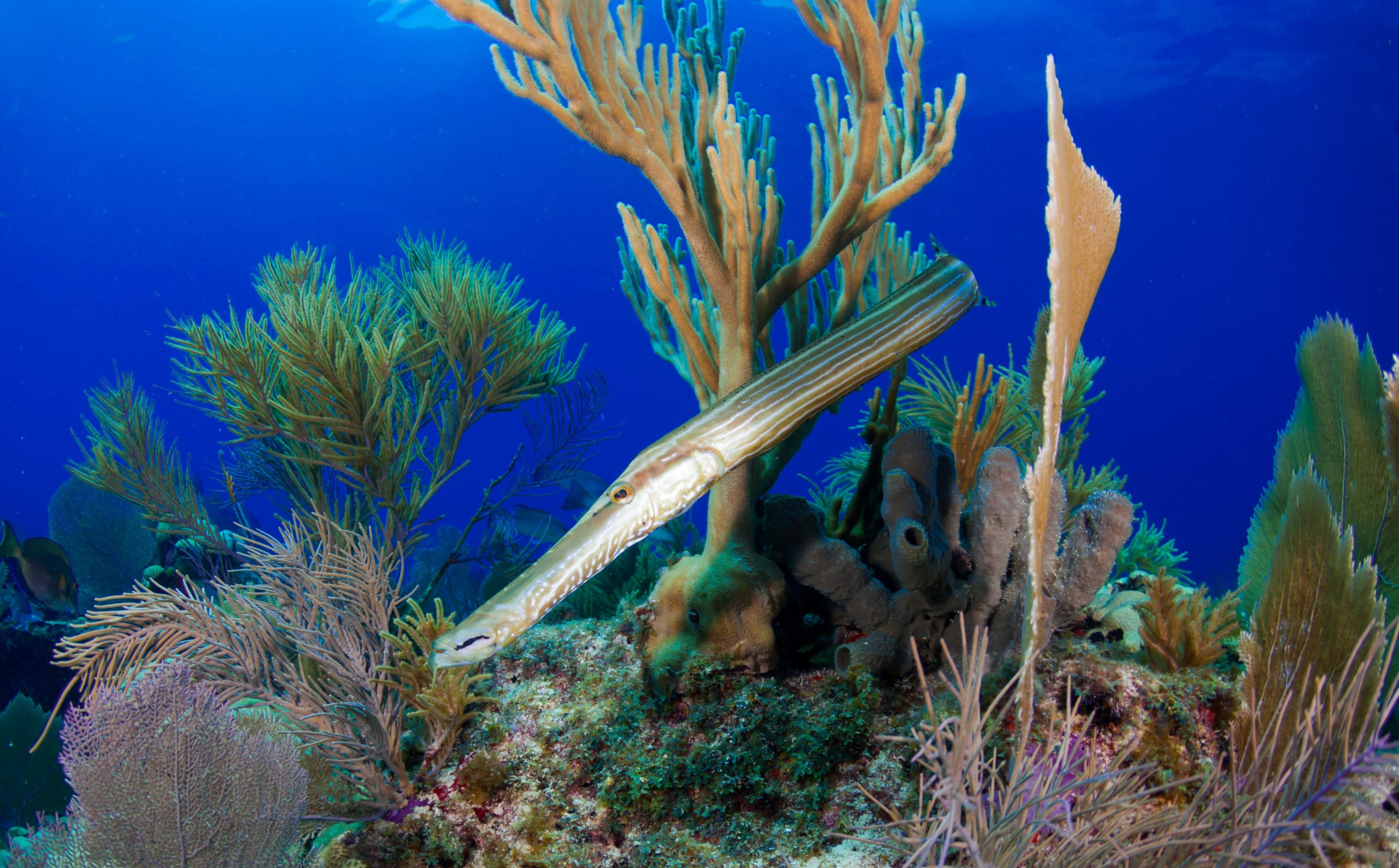
Sea Wonder: Trumpetfish

Trumpetfish swimming in Florida Keys National Marine Sanctuary. Photo: Beata Lerman
Strike up the band for this unmistakable reef fish! It’s none other than trumpetfish (family Aulostomus), three species of long fishes with trumpet-like bodies. Unfortunately, they can’t play us any of Louis Armstrong’s greatest hits, but they are beautiful and quite the sight to see when SCUBA diving on coral reefs!
Description
Trumpetfish are closely related to pipefish and seahorses. There are three species of trumpetfishes, two in the Atlantic and one in the Indo-Pacific: the trumpetfish (Aulostomus maculatus), the Atlantic trumpetfish (Aulostomus strigosus), and the Chinese trumpetfish (Aulostomus chinesis). They all share characteristic of long, skinny bodies with tubular snouts, spines along their backs, and a single barbel on their chins. Within their mouths are several tiny teeth, but don’t let that fool you – they can expand their jaws to nearly the size of their bodies when feeding!
Like other fishes, they have gills, fins, and move their tails in a side-to-side motion to swim. They can grow to be between two and three feet long, and their weights aren’t well documented. Their coloration ranges from mottled brown to bright yellow, with the most common colorations being reddish brown with black spots and silvery streaks. Trumpetfishes can perform slight changes in color to camouflage when needed, which is made possible by specialized skin cells called chromatophores.
Diet & Habitat

Trumpetfish in the Caribbean. Photo: Julie Bedford/NOAA/Public and Constituent Affairs
Trumpetfishes are strict carnivores that feed on smaller fish and invertebrates. The exact composition of their diet depends on where in the ocean they live, but they don’t seem to be picky, going for whatever is easiest to catch and eat. They are fairly passive hunters that prefer to stalk and then ambush their prey rather than undertake high-speed pursuits. They often trick their prey by hovering motionless above the reef and slowly swim behind their target before opening their mouths wide, ambushing their prey, and sucking it into their mouths like a straw before swallowing the victim whole. Oftentimes, these fish will swim vertically to blend in with the coral communities around them. Another display of these species’ cunning is that they have been documented using other fish as cover, hiding behind sea fans or swimming among larger herbivorous fish and ambushing unsuspecting smaller fish when the opportunity arises.
Trumpetfishes live near coral reefs, seagrass beds, or rocky substrates in tropical and subtropical waters throughout the Atlantic, Indian, and Pacific oceans. Because of their habitat needs, trumpetfish live in shallower coastal waters between six and 80 feet deep. In the National Marine Sanctuary System, we see them in and near Florida Keys, Flower Garden Banks, Gray’s Reef, and Hawaiian Islands Humpback Whale national marine sanctuaries.
Life History
Scientists don’t know much about the reproductive behavior and cycles of trumpetfish, but we do know their color changing abilities play a key role in mating rituals. Courtship occurs near the water’s surface where males rapidly change colors while moving in dance-like patterns, seemingly to attract and impress females. We know that, like seahorses, a female who has selected a mate will transfer her eggs to the male, who fertilizes and incubates them in a specialized pouch on their bodies until the eggs hatch and the larvae emerge into the water column. Most newly hatched trumpetfish are not strong enough to swim against currents and are at the mercy of the ocean’s movements until they reach their juvenile stages. We don’t yet know the maximum or average lifespans of these fish, but it is likely only a few years, similar to seahorses and pipe fishes.
Threats & Conservation
Trumpetfishes are not targets of commercial or recreational fishing, but their appearance makes them somewhat popular in the aquarium trade. They are often accidentally caught in seine nets and other traps as bycatch. The International Union for Conservation of Nature (IUCN) has not evaluated these species because they are pretty rare and not easily or commonly studied. Since they rely on seagrass beds and coral reefs, threats to trumpetfish populations definitely include climate change and ocean acidification, habitat loss and damage, and pollution and coastal development.

A trumpetfish blends in with its surroundings in Dry Tortugas of Florida Keys National Marine Sanctuary. Photo: Greg McFall/NOAA
